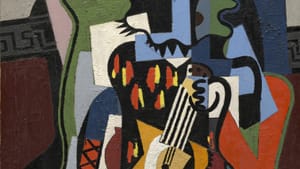Stay in the Loop
BSR publishes on a weekly schedule, with an email newsletter every Wednesday and Thursday morning. There’s no paywall, and subscribing is always free.
Thinking outside the cubist box
Picasso: The Great War at the Barnes Foundation

When World War I broke out, French and British publications denounced cubist art. They spoke of cubism’s breaking up and fragmenting of objects as analogous to Germany’s precipitating a world war. Newspaper cartoons attacked the genre.
The French establishment had long felt that cubism was foreign to their culture. The work of Pablo Picasso, the most famous cubist, was promoted by the German dealer Daniel-Henry Kahnweiler, causing many French people to associate cubism with the hated Germans. In addition, the French were suspicious of Spain, Picasso’s birthplace, which stayed neutral but had significant conservative factions (the aristocracy, the Catholic Church, and the Spanish Army) that favored the German cause, in part because of admiration of Prussian militarism.
All of this put Picasso’s career in a precarious position.
The 33-year-old Picasso stayed in the artist quarter of Bateau-Lavoir in Paris. A Spanish national, he was not drafted into the French army as many of his fellow artists were. He never directly addressed the war as a subject in his art, but it influenced him tremendously, causing him to radically change his style.
A sudden change
After ten years (1909-1919) concentrating on geometrical cubist forms, Picasso made an abrupt shift and started painting naturalistically, almost classically. He allowed people to think that he abandoned cubism. But this exhibit discloses that Picasso did not renounce that style. Throughout the conflict and into the 1920s he alternately created cubist and natural paintings.
Two contrasting canvases hang next to each other in the show. Harlequin Musician is severe, almost abstract — a veritable paradigm of cubism. Two feet away is Pierrot, a naturalist painting of a melancholic seated figure in a gracefully fluted garment. His hands are holding a mask, which provides a small link to the Harlequin.

Picasso sometimes combined elements of both forms in one work of art, as in Studies, a 1920 oil in which cubist still lifes abut classical figure studies on one canvas. There are obviously sharp differences between the two styles, but Picasso said that the two approaches were not necessarily antithetical: “If the subjects I have wanted to express have suggested different ways of expression, I have never hesitated to adopt them.”
Freedom of expression
Simonetta Fraquelli, curator of this exhibition, says that Picasso did not repudiate cubism, but rather made “a passionate declaration of his freedom of expression.” She spoke at the exhibition’s opening, and she contributed a chapter to the catalog.
Objects were loaned by private owners and by European and American museums for this exhibition, which is separate from the Barnes's permanent collection. In addition, the Barnes holds ten Picassos from the same period that cannot be removed from the spaces chosen by Albert Barnes. Patrons should take the opportunity to see them during their visit. I especially recommend lingering in room 10 before Still Life: Glass and Peach, one of his later cubist paintings, circa 1923.
Toward the end of the war, Picasso designed sets and costumes Parade by Diaghilev’s Ballets Russe, presented in Paris with a story by Jean Cocteau, choreography by Léonide Massine, and music by Erik Satie. Picasso’s set caricatured modern life in a cubist manner but the curtain he designed was classical. The large papier-mâché figures he constructed for the production stand in the center of the Barnes show. One of his original costumes also is on display. Videos of a production of Parade and a documentary about Picasso during the war are welcome additions in the midst of the exhibit.
What, When, Where
Picasso: The Great War, Experimentation and Change. An exhibition created jointly by the Columbus Museum of Art and the Barnes Foundation. Through May 9, 2016 at the Barnes Foundation, 2015 Benjamin Franklin Parkway, Philadelphia. barnesfoundation.org.
Picasso: The Great War, Experimentation and Change by Simonetta Fraquelli, Elizabeth Cowling, Kenneth E. Silver, Dominique H. Vasseur, and Ann Bremner. Scala Arts Publishers, 2016. scalapublishers.com
Sign up for our newsletter
All of the week's new articles, all in one place. Sign up for the free weekly BSR newsletters, and don't miss a conversation.

 Steve Cohen
Steve Cohen